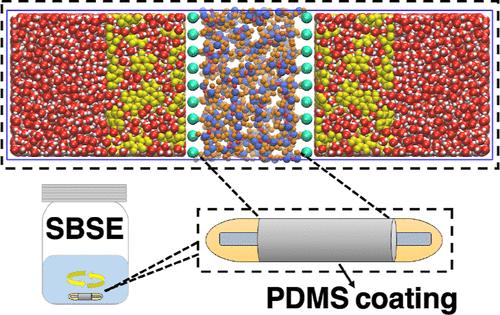聚二甲基硅氧烷层的界面分离。涂层搅拌棒从水溶液中萃取有机物的分子建模
IF 3.9
2区 化学
Q2 CHEMISTRY, MULTIDISCIPLINARY
引用次数: 0
摘要
依靠界面相互作用的分离过程,如搅拌棒吸附萃取,是环境、食品和生物医学样品中痕量有机分析物检测和提取的最关键方法之一。而聚二甲基硅氧烷(PDMS)作为SBSE的吸附涂层具有较高的灵敏度和效率;涉及的分子机制探索较少。本研究利用分子动力学(MD)研究了有机化合物(包括苯酚、氯酚、愈创木酚、苯甲醇和苯乙醇)在水- pdms界面上的吸收,并重点研究了温度依赖性行为。通过对PDMS、有机化合物和水采用适当的力场,这些模拟可以直接预测PDMS-水分配系数、log P [PDMS/水]、扩散系数和PDMS相的溶解度,而无需依赖辛醇-水分配作为替代。在这项工作中,MD模拟的一个重要结果是我们能够预测logp (PDMS/water)的温度依赖性。结果表明,对数P [PDMS/water]值具有非单调的温度依赖吸附趋势。然而,我们发现,随着温度的升高,PDMS相中有机分子的绝对数量增加,这是由于分子扩散增强和PDMS显著的吸附能力。研究结果表明,在高温下进行SBSE可以增强分析物的吸收,提高痕量水平提取的分析灵敏度,在环境监测、食品安全和生物医学分析等各种应用中,在吸附相中获得足够的分析物浓度对于可靠的检测和定量至关重要。模拟结果表明,温度是优化SBSE运行条件的一个很好的参数。我们的研究结果还强调了MD模拟可靠地捕获控制SBSE性能的复杂分子水平相互作用的能力,这与实验趋势和观察到的行为很好地吻合。本文章由计算机程序翻译,如有差异,请以英文原文为准。

Interfacial Separations by a Polydimethylsiloxane Layer. Molecular Modeling of Coated Stir Bar Extraction of Organics from Aqueous Solutions
Separation processes relying on interfacial interactions, such as the stir bar sorptive extraction represent one of the most critical methods of analyte trace organic detection and extraction in environmental, food, and biomedical samples. While the use of polydimethylsiloxane (PDMS) as a sorptive coating in SBSE has exhibited high sensitivity and efficiency; the molecular mechanisms involved are less explored. We report molecular simulation studies using molecular dynamics (MD) to investigate the absorption of organic compounds including phenol, chlorophenol, guaiacol, benzyl alcohol, and phenethyl alcohol at the aqueous-PDMS interface, and focus on temperature-dependent behavior. By employing an appropriate force field for PDMS, organic compounds, and water, these simulations directly predict PDMS-water partition coefficients, log P [PDMS/water], diffusion coefficients, and solubilities in the PDMS phase without relying on octanol–water partitioning as a surrogate. An important result of the MD simulations in this work is our ability to predict the temperature dependence of the log p(PDMS/water). Results reveal a nonmonotonic temperature-dependent sorption trend for log P [PDMS/water] values. However, we find that with increasing temperature, the absolute number of organic molecules in the PDMS phase increases, driven by enhanced molecular diffusion and PDMS’s significant sorption capacity. The findings demonstrate that performing SBSE at elevated temperatures can enhance analyte uptake, improving the analytical sensitivity of trace level extractions, where achieving sufficient analyte concentration in the sorptive phase is critical for reliable detection and quantification in a wide variety of applications in environmental monitoring, food safety, and biomedical analysis. These simulations predict that temperature is a good parameter for the optimization of operating conditions of SBSE. Our results also highlight the ability of MD simulations to reliably capture complex molecular level interactions governing SBSE performance, aligning well with experimental trends and observed behaviors.
求助全文
通过发布文献求助,成功后即可免费获取论文全文。
去求助
来源期刊

Langmuir
化学-材料科学:综合
CiteScore
6.50
自引率
10.30%
发文量
1464
审稿时长
2.1 months
期刊介绍:
Langmuir is an interdisciplinary journal publishing articles in the following subject categories:
Colloids: surfactants and self-assembly, dispersions, emulsions, foams
Interfaces: adsorption, reactions, films, forces
Biological Interfaces: biocolloids, biomolecular and biomimetic materials
Materials: nano- and mesostructured materials, polymers, gels, liquid crystals
Electrochemistry: interfacial charge transfer, charge transport, electrocatalysis, electrokinetic phenomena, bioelectrochemistry
Devices and Applications: sensors, fluidics, patterning, catalysis, photonic crystals
However, when high-impact, original work is submitted that does not fit within the above categories, decisions to accept or decline such papers will be based on one criteria: What Would Irving Do?
Langmuir ranks #2 in citations out of 136 journals in the category of Physical Chemistry with 113,157 total citations. The journal received an Impact Factor of 4.384*.
This journal is also indexed in the categories of Materials Science (ranked #1) and Multidisciplinary Chemistry (ranked #5).
 求助内容:
求助内容: 应助结果提醒方式:
应助结果提醒方式:


